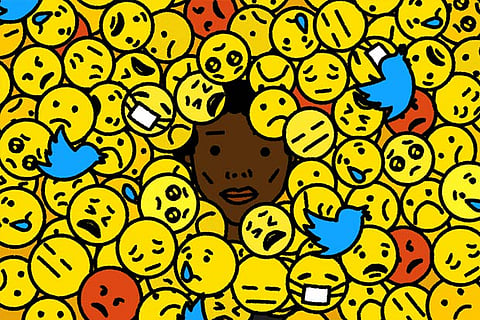

Chennai
The Computational Story Lab of the University of Vermont offers this answer: Sunday, May 31. That day was not only the saddest day of 2020 so far, it was also the saddest day recorded by the lab in the last 13 years. Or at least, the saddest day on Twitter.
The researchers call it the Hedonometer. It is the invention of Chris Danforth and his partner Peter Dodds, both trained mathematicians and computer scientists and the co-directors of the lab. The Hedonometer has been up and running for more than a decade now, measuring word choices across millions of tweets, every day, the world over, to come up with a moving measure of well-being. In fact, the last time we checked in with the Hedonometer team, in 2015, the main finding to emerge was our tendency toward relentless positivity on social media. “One of the happiest years on Twitter, at least for English,” Dr. Danforth said recently with a note of rue. That result now seems an artifact from an ancient era. “Since then it has been a long decline.”
What has remained constant is this: “Happiness is hard to know. It’s hard to measure,” he said. “We don’t have a lot of great data about how people are doing.” The Computational Story Lab is part of a small but growing field of researchers who try to parse our national mental health through the prism of our online life. After all, never before have we had such an incredible stockpile of real-time data — what’s known as our “digital traces”— to choose from.
And never has that stockpile of information towered as high as it does now, in the summer of 2020: In the first months of the pandemic, Twitter reported a 34 per cent increase in daily average user growth.
Without our normal social life as antidote and anchor, our social media now feels more like real life than ever before.
Since 2008, the Hedonometer has gathered a random 10 pc of all public tweets, every day, across a dozen languages. The tool looks for words that have been ranked for their happy or sad connotation, counts them, and calculates a kind of national happiness average based on which words are dominating the discourse.
On May 31, the most commonly used words on English language Twitter included “terrorist,” “violence” and “racist.” This was about a week after George Floyd was killed, near the start of the protests that would last all summer.
Since the beginning of the pandemic, the Hedonometer’s sadness readings have set multiple records. This year, “there was a full month — and we never see this — there was a full month of days that the
Hedonometer was reading sadder than the Boston Marathon day,” Dr. Danforth said. “Our collective attention is very ephemeral. So it was really remarkable then that the instrument, for the first time, showed this sustained, depressed mood, and then it got even worse, when the protests started.”
Munmun De Choudhury, a professor in the School of Interactive Computing at Georgia Tech, is also examining digital data for insights into well-being. Dr. De Choudury’s work over the years has focused not only on population studies, like the Hedonometer, but also on the individual. “If I’m constantly talking about ‘me,’ it means my attention has inward focus,” Dr De Choudury said. “In the context of other markers, it can be a correlate of mental illness.”
As per Gallup, Americans reported the lowest rates of life satisfaction this year in over a decade, including during the 2008 recession. These statistics are consistent with more IRL observations: like the experience of many therapists working long days on Zoom to help patients cope with the same crisis they themselves are going through. “I have never been more exhausted at the end of the day than I am now,” said Michael Garfinkle, a psychoanalyst in New York.
— Casey Schwartz is a reporter with NYT©2020
The New York Times
Visit news.dtnext.in to explore our interactive epaper!
Download the DT Next app for more exciting features!
Click here for iOS
Click here for Android